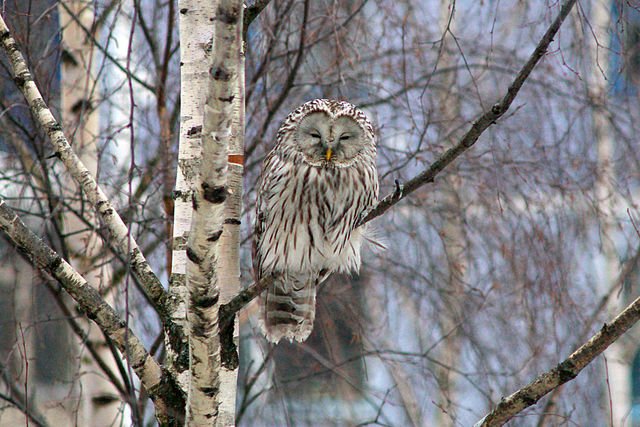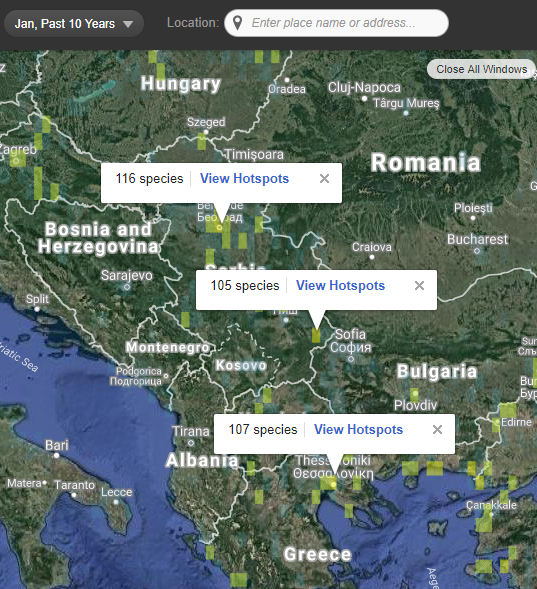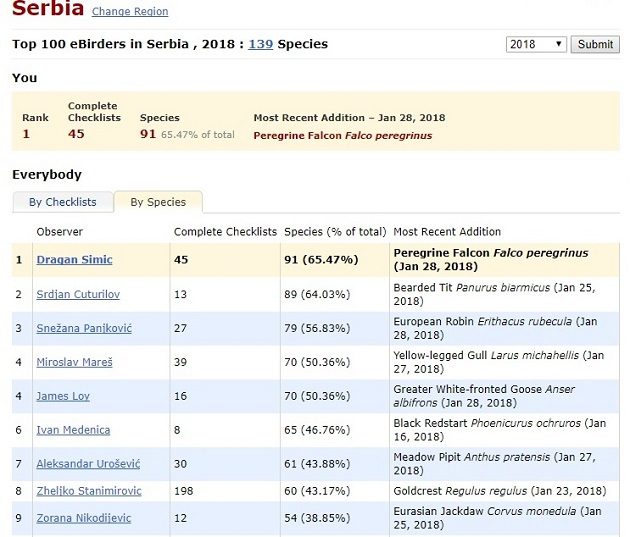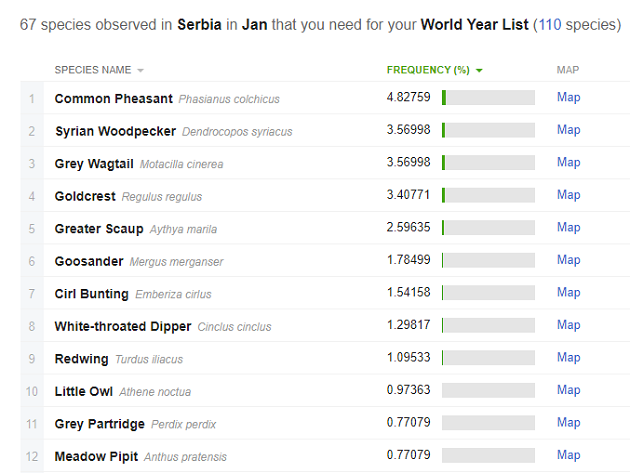
I screamed “UralOwlUralOwlUralOwl!!!”, all the time pointing with my right hand while holding the steering wheel with my left, and the hardest thing, keeping my eyes on the road. Fortunately, B. managed to see it, his largest owl ever. I had just a split-second glimpse of this species – my only second ever – yet immediately knew what is it, but I was driving through a snowbound countryside and had another car behind me, therefore I stopped a good 50 metres later to eBird it. How I managed to ID the Ural Owl so easily with such a short observation window, beats me. It came by automatism.
Cover photo: Ural Owl Strix uralensis by Serge Serebro / Wikimedia Commons
It is the end of January and my year list reached 110 birds. How does it compare within the region? More productive areas of the Balkans have January eBird lists from 105 to 115 species (but I combined several areas in two countries, Greece and Serbia), so I have every reason to be satisfied.

Am I satisfied? Without rarities and vagrants, Serbia has 333 regularly occurring species and my national list of 91 birds represent a good 27 per cent of local bird diversity.

Yet, checking my remaining January targets, I realise that I could have easily had 4 or 5 more species.

The silver lining is, tomorrow I should be counting thousands of gulls and will stand a chance to find the two missing species, Lesser and Great Black-backed Gulls. Talking of gulls, I had a new meeting with an old acquaintance, the Black-headed Gull ringed in 2013 in the north of the country that I already met twice in 2015 and now again – I even recognized its ring because the combination of letters sounds a bit like “Yahoo”.
The best birds so far were two rare geese, Lesser White-fronted and Red-breasted Goose (both my second observations ever), plus Bewick’s Swan and Red-crested Pochard – all in Greece. Then, Black-throated Diver (Serbia), Greater Spotted Eagle (Greece – only my second observation in Europe, and the third, and the fourth…), Northern Goshawk (Serbia, this one getting so rare that I haven’t seen it in last few years), Temminck’s Stint (Greece – my first for Europe), Herring Gull (Serbia – supposed to be rare, but more likely regular, ill-numbered and overlooked), Ural Owl (Serbia – my second ever), Grey-headed Woodpecker (Serbia – the least common of common peckers), Peregrine Falcon (Serbia – becoming ever rarer), Western Rock Nuthatch (Greece – such a joy to see) and Eurasian Treecreeper (Serbia – silent and not a small feat to manage to observe its wingtips to tell it apart from identical Short-toed Treecreeper).
My January 2018 list (4 birds in bold are globally threatened):
1. Greylag Goose – Anser anser
2. Greater White-fronted Goose – Anser albifrons
3. Lesser White-fronted Goose – Anser erythropus
4. Red-breasted Goose – Branta ruficollis
5. Mute Swan – Cygnus olor
6. Bewick’s Swan – Cygnus columbianus
7. Common Shelduck – Tadorna tadorna
8. Northern Shoveler – Spatula clypeata
9. Gadwall – Mareca strepera
10. Eurasian Wigeon – Mareca penelope
11. Mallard – Anas platyrhynchos
12. Northern Pintail – Anas acuta
13. Eurasian Teal – Anas crecca
14. Red-crested Pochard – Netta rufina
15. Common Pochard – Aythya ferina
16. Ferruginous Duck – Aythya nyroca
17. Tufted Duck – Aythya fuligula
18. Common Goldeneye – Bucephala clangula
19. Smew – Mergellus albellus
20. Black-throated Diver – Gavia arctica
21. Little Grebe – Tachybaptus ruficollis
22. Great Crested Grebe – Podiceps cristatus
23. Black-necked Grebe – Podiceps nigricollis
24. Greater Flamingo – Phoenicopterus roseus
25. Black Stork – Ciconia nigra
26. Pygmy Cormorant – Microcarbo pygmeus
27. Great Cormorant – Phalacrocorax carbo
28. Dalmatian Pelican – Pelecanus crispus
29. Grey Heron – Ardea cinerea
30. Great White Egret – Ardea alba
31. Glossy Ibis – Plegadis falcinellus
32. Eurasian Spoonbill – Platalea leucorodia
33. Greater Spotted Eagle – Clanga clanga
34. Western Marsh Harrier – Circus aeruginosus
35. Hen Harrier – Circus cyaneus
36. Eurasian Sparrowhawk – Accipiter nisus
37. Northern Goshawk – Accipiter gentilis
38. White-tailed Eagle – Haliaeetus albicilla
39. Common Buzzard – Buteo buteo
40. Common Moorhen – Gallinula chloropus
41. Eurasian Coot – Fulica atra
42. Common Crane – Grus grus
43. Northern Lapwing – Vanellus vanellus
44. Eurasian Curlew – Numenius arquata
45. Ruff – Calidris pugnax
46. Temminck’s Stint – Calidris temminckii
47. Dunlin – Calidris alpina
48. Common Snipe – Gallinago gallinago
49. Green Sandpiper – Tringa ochropus
50. Black-headed Gull – Chroicocephalus ridibundus
51. Common Gull – Larus canus
52. Herring Gull – Larus argentatus
53. Yellow-legged Gull – Larus michahellis
54. Caspian Gull – Larus cachinnans
55. Feral Pigeon – Columba livia
56. Common Woodpigeon – Columba palumbus
57. Collared Dove – Streptopelia decaocto
58. Ural Owl – Strix uralensis
59. Long-eared Owl – Asio otus
60. Common Kingfisher – Alcedo atthis
61. Lesser Spotted Woodpecker – Dendrocopos minor
62. Middle Spotted Woodpecker – Dendrocopos medius
63. Great Spotted Woodpecker – Dendrocopos major
64. Black Woodpecker – Dryocopus martius
65. Eurasian Green Woodpecker – Picus viridis
66. Grey-headed Woodpecker – Picus canus
67. Common Kestrel – Falco tinnunculus
68. Peregrine Falcon – Falco peregrinus
69. Great Grey Shrike – Lanius excubitor
70. Eurasian Jay – Garrulus glandarius
71. Common Magpie – Pica pica
72. Eurasian Jackdaw – Corvus monedula
73. Rook – Corvus frugilegus
74. Hooded Crow – Corvus cornix
75. Common Raven – Corvus corax
76. Bearded Tit – Panurus biarmicus
77. Woodlark – Lullula arborea
78. Eurasian Skylark – Alauda arvensis
79. Crested Lark – Galerida cristata
80. Coal Tit – Periparus ater
81. Marsh Tit – Poecile palustris
82. Eurasian Blue Tit – Cyanistes caeruleus
83. Great Tit – Parus major
84. Long-tailed Tit – Aegithalos caudatus
85. Eurasian Nuthatch – Sitta europaea
86. Western Rock Nuthatch – Sitta neumayer
87. Eurasian Treecreeper – Certhia familiaris
88. Eurasian Wren – Troglodytes troglodytes
89. Sardinian Warbler – Sylvia melanocephala
90. European Robin – Erithacus rubecula
91. Black Redstart – Phoenicurus ochruros
92. Eurasian Blackbird – Turdus merula
93. Fieldfare – Turdus pilaris
94. Mistle Thrush – Turdus viscivorus
95. Common Starling – Sturnus vulgaris
96. White Wagtail – Motacilla alba
97. Water Pipit – Anthus spinoletta
98. Yellowhammer – Emberiza citrinella
99. Common Reed Bunting – Emberiza schoeniclus
100. Corn Bunting – Emberiza calandra
101. Common Chaffinch – Fringilla coelebs
102. Brambling – Fringilla montifringilla
103. Hawfinch – Coccothraustes coccothraustes
104. Eurasian Bullfinch – Pyrrhula pyrrhula
105. European Greenfinch – Chloris chloris
106. Common Linnet – Linaria cannabina
107. European Goldfinch – Carduelis carduelis
108. Eurasian Siskin – Spinus spinus
109. House Sparrow – Passer domesticus
110. Eurasian Tree Sparrow – Passer montanus













Yesterday, while counting gulls all the way till the super blue blood moonrise, one Lesser Black-backed Gull – the species #111 for January, made my day.
Very cool, oh how I would love to be able to also shout “Ural Owl” in the same circumstances.
I was thinking “should I add ‘only my second in ten years’”, but didn’t. Never used playback on them. Yet, this roadside Urals are becoming a commoner phenomenon in recent years.
You’re having a great year so far. I ended January with far fewer species and one less owl.
This was possibly my best January in the Balkans ever (72 birds in Greece + 92 in Serbia = 111), but I remember travelling to India in January, so it is not my best January worldwide. Still, sort of a kickstart 😉
Dragan! Many thanks for three fantastic days of birding Serbia. You are truly the “Balkan Bird Whisperer.” The birds and environment of Serbia are sooooo fortunate to have an advocate on their behalf in you. You are the man!!!